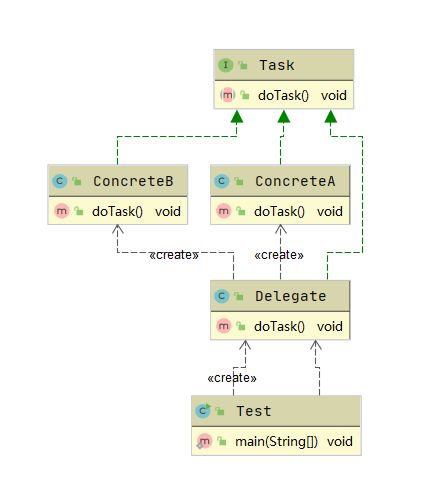简介
委派模式(Delegate Pattern)又叫委托模式,是一种面向对象的设计模式,允许对象组合实现与继承相同的代码复用。它的基本作用就是负责任务的调用和分配任务,是一种特殊的静态代理,可以理解为全权代理,但是代理模式注重过程,而委派模式注重结果。委派模式属于行为模式,不属于GOF 23设计模式。
委派模式的UML类图:

从类图中我们可以看到,委派模式有三个参与角色:
抽象人物角色(Task):定义一个抽象接口,它由若干实现类。
委派者角色(Delegate):负责在各个具体角色实例之间做出决策,并判断兵调用具体实现的方法。
具体任务角色(Concrete):真正执行任务的角色。
委派模式现实的业务场景
1、老板给项目经理下达任务
2、授权委托书
委派模式在源码中的体现
JDK有个典型的委派,JVM在加载类使用的双亲委派模式。就是类在加载时,先把这个请求委派给自己的父类加载器去执行,如果父类加载器还存在父类加载器就继续向上委派,知道顶层的启动类加载器。如果父类加载器能够完成类加载,就成功返回,如果父类加载器无法完成加载,那么子加载器才会尝试自己去加载。
1、ClassLoad中loadClass()方法
protected Class<?> loadClass(String name, boolean resolve)
throws ClassNotFoundException
{
synchronized (getClassLoadingLock(name)) {
// First, check if the class has already been loaded
Class<?> c = findLoadedClass(name);
if (c == null) {
long t0 = System.nanoTime();
try {
if (parent != null) {
c = parent.loadClass(name, false);
} else {
c = findBootstrapClassOrNull(name);
}
} catch (ClassNotFoundException e) {
// ClassNotFoundException thrown if class not found
// from the non-null parent class loader
}
if (c == null) {
// If still not found, then invoke findClass in order
// to find the class.
long t1 = System.nanoTime();
c = findClass(name);
// this is the defining class loader; record the stats
sun.misc.PerfCounter.getParentDelegationTime().addTime(t1 - t0);
sun.misc.PerfCounter.getFindClassTime().addElapsedTimeFrom(t1);
sun.misc.PerfCounter.getFindClasses().increment();
}
}
if (resolve) {
resolveClass(c);
}
return c;
}
}
2、Method类里常用代理执行方法invoke()也存在类似的机制。
public Object invoke(Object obj, Object... args)
throws IllegalAccessException, IllegalArgumentException,
InvocationTargetException
{
if (!override) {
if (!Reflection.quickCheckMemberAccess(clazz, modifiers)) {
Class<?> caller = Reflection.getCallerClass();
checkAccess(caller, clazz, obj, modifiers);
}
}
MethodAccessor ma = methodAccessor; // read volatile
if (ma == null) {
ma = acquireMethodAccessor();
}
return ma.invoke(obj, args);
}
3、Spring中的应用
- spring IOC模块中的
DefaultBeanDefinitionDocumentReader类,在调用doRegisterBeanDefinitions()方法。
protected void doRegisterBeanDefinitions(Element root) {
BeanDefinitionParserDelegate parent = this.delegate;
this.delegate = createDelegate(getReaderContext(), root, parent);
if (this.delegate.isDefaultNamespace(root)) {
String profileSpec = root.getAttribute(PROFILE_ATTRIBUTE);
if (StringUtils.hasText(profileSpec)) {
String[] specifiedProfiles = StringUtils.tokenizeToStringArray(
profileSpec, BeanDefinitionParserDelegate.MULTI_VALUE_ATTRIBUTE_DELIMITERS);
// We cannot use Profiles.of(...) since profile expressions are not supported
// in XML config. See SPR-12458 for details.
if (!getReaderContext().getEnvironment().acceptsProfiles(specifiedProfiles)) {
if (logger.isDebugEnabled()) {
logger.debug("Skipped XML bean definition file due to specified profiles [" + profileSpec +
"] not matching: " + getReaderContext().getResource());
}
return;
}
}
}
preProcessXml(root);
parseBeanDefinitions(root, this.delegate);
postProcessXml(root);
this.delegate = parent;
}
protected void parseBeanDefinitions(Element root, BeanDefinitionParserDelegate delegate) {
//判断节点是否属于同一个命名空间,是则执行后续的解析
if (delegate.isDefaultNamespace(root)) {
NodeList nl = root.getChildNodes();
for (int i = 0; i < nl.getLength(); i++) {
Node node = nl.item(i);
if (node instanceof Element) {
Element ele = (Element) node;
if (delegate.isDefaultNamespace(ele)) {
parseDefaultElement(ele, delegate);
}
else {
//注解定义的Context的nameSpace进入到这个分支中
delegate.parseCustomElement(ele);
}
}
}
}
else {
delegate.parseCustomElement(root);
}
}
SpringMVC的DispatcheServlet等等
委派模式的优缺点
优点:
通过任务委派能够将一个大型的任务细化,然后通过统一管理这些子任务的完成情况实现任务的跟进,能够加快任务执行的效率。
缺点:
任务委派方式需要根据任务的复杂程度进行不同的改变,在任务比较复杂的情况下可能需要进行多重委派,容易造成紊乱。